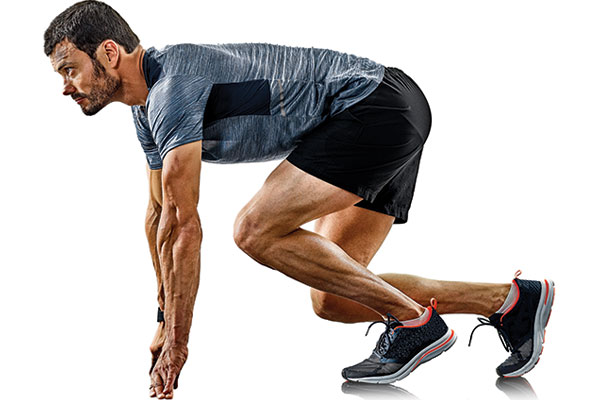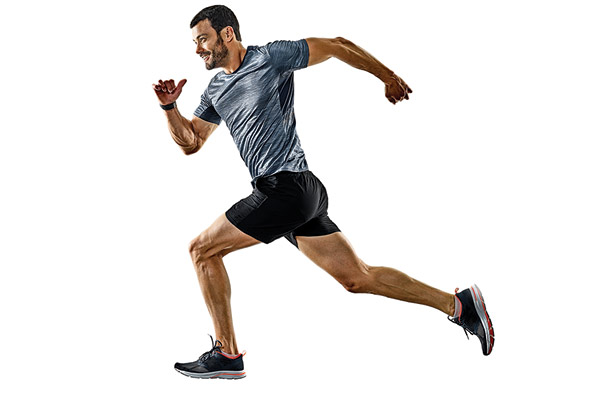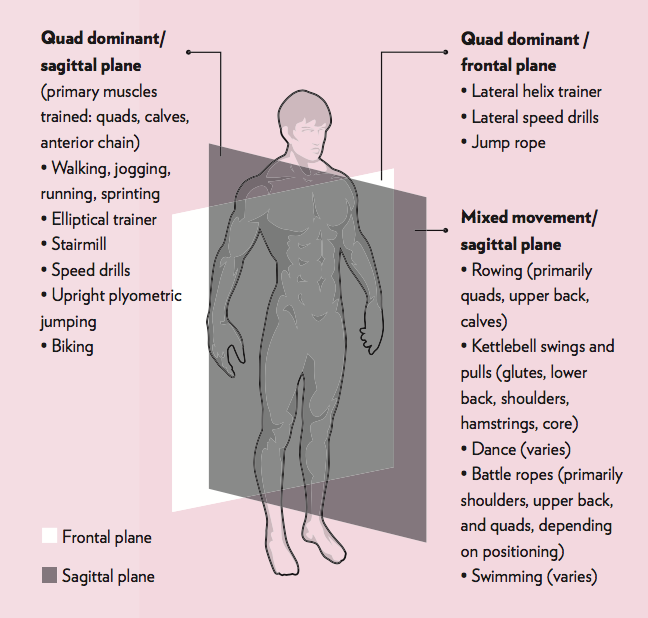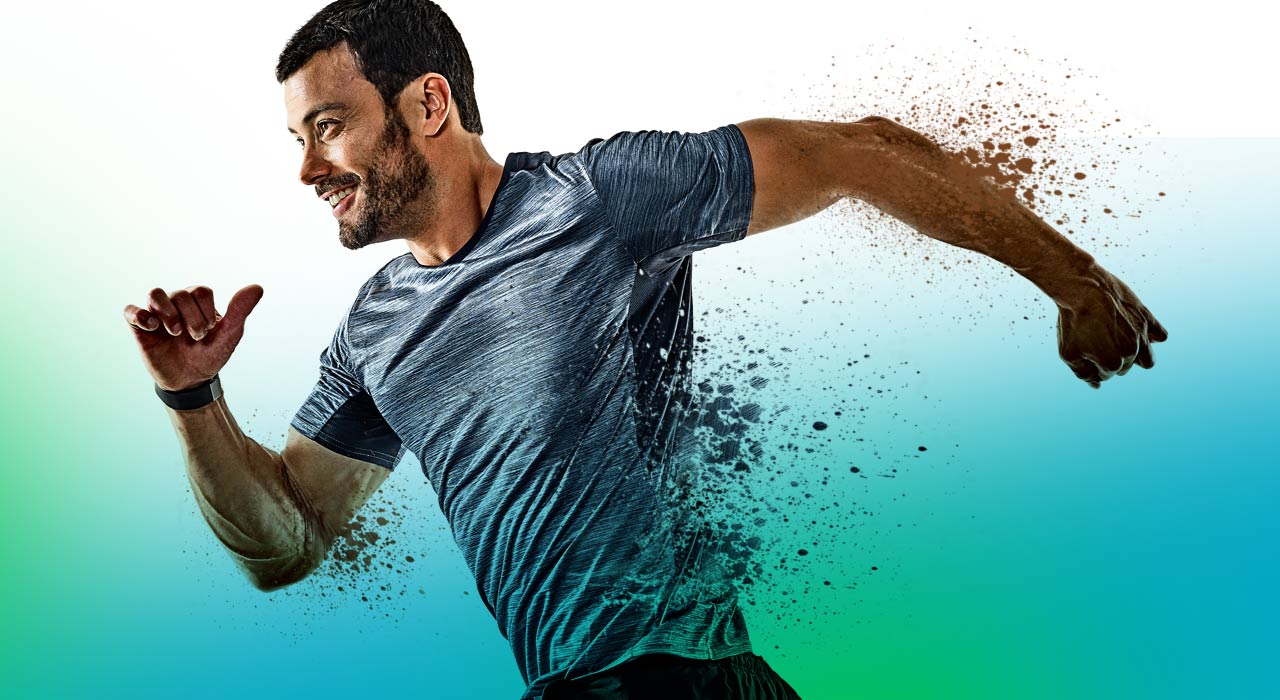Is cardio destroying you? If you’ve got a pet style of cardio, you could be unraveling one step at a time. Here’s an easy low impact cardio program fix for your imbalances so your body stays strong for the long haul.
TRAINER – Brandan Fokken: IFBB physique pro, Bodybuilding.com and Dymatize athlete.
Who does cardio create imbalances and injuries for?
Picture in your mind’s eye those awesome endurance athletes who’ve been running for years, and have probably clocked up a few marathons. Inspiring, right? Thousands of hours committed to a single, steady movement.
Now, try to draw your attention to those body types who have been into running for a long time but haven’t mastered the gait or perfect alignment.
When you look at how that’s impacted their body, you’ll notice a forward and posteriorly rotated hip (meaning minimal glutes as well), and often a rounded forward upper back.
Sure, they’re lean and can run forever, but do you ever wonder what happens to the joints or muscles around them?
Keep reading to find out what’s happening to your body while you’re sweating off your excesses.

Cardio – creating dominant muscles and weakening others?
Movement pattern overload is common for those who choose to do the cardio they are naturally good at performing. If you’re a runner, you’d probably stick with it as your preferred cardio.
The same goes for someone who enjoys biking, swimming and so on, but the real problems creep in when your method of choice isn’t balanced by other forms of training which get opposing muscles involved.
Take the running example again. Even when done properly, it’s still basically a quad-dominant exercise. Over time, the body lets go of muscle mass that isn’t required to stick around.
This means your glutes, hamstrings, upper back and shoulders (to name a few) will begin to slowly waste away in favor of preserving the muscles used for the activity.
Biking and stairmills are similar in their demands when done for aerobic training over a prolonged period of time. Long-term damage occurs through compensations and familiar movement pathways in training.
Spot your weaknesses and fix imbalances
What’s important is to learn how to identify movement pattern issues, to change cardio training in order to help regain muscle balance in your body, and to undo these compensations and improve weaknesses.
As you do this, you have potential to initiate improvements in muscle growth for specific areas. This means by changing the demand and introducing new movement patterns, or improving the way your body performs typical patterns, even your cardio can be geared towards gaining muscle.
OK, that’s typically only seen when someone is transitioning from a more sedentary life to a more active one, but it’s worth noting that regardless of whether the person is sedentary or more active, immediate responses to training are going to be much more neuromuscular and relate to fluid retention capabilities within the muscle rather than functional strength and muscle fiber growth.
You can expect to wait a few months for evidence of notable growth.

The 3 step test for finding your cardio imbalances
It’s important to identify which muscles you’re over using when doing your preferred style of cardio. The first step is to try filming yourself on your phone during your next session. Plan to do an extended workout and get yourself really fatigued. This will be the best way to diagnose how pattern overload is affecting your body.
- Be sure to get a quick video of yourself prior to your workout, where you’re just standing and walking around.
- Next, film 15-30 seconds at the beginning, plus grab a clip of your mid-
way point. - Finally, take one last video right at the end of your workout and one of your posture when you’re walking around immediately after.
What do you see? Do you notice you’re pretty hunched over? If you’re running, are your heels striking the ground first, or is it the front of your foot? What are your hips doing? Do they move naturally from side-to-side slightly with your leg stride, or are they locked into place? What about your head and neck?
What does this say about which muscles are pretty bound-up for you? Here’s a little problem solving cheat sheet.

-
HIPS
If your hips don’t move at all, your glutes, IT Band and lower back are too tight and this means force is not distributed evenly though your body. This will cause tension in your
lower back and most likely lead to knee issues.
2. SHOULDERS
If your shoulders are rounding forward, then your chest and anterior delts are getting tight, causing limitations in lung capacity. This leads to more rapid fatigue, because your air supply is lower.
Above all, don’t worry about these: there’s a training plan to come that will improve your posture, strength and cardio capacity.
Which cardio exercises cause what weaknesses?
Most cardio plans only train one plane of motion – forward or back, aka the sagittal plane.
As you know, this isn’t the only direction your body moves in, so incorporating lateral training alongside rotational work will increase the metabolic and aerobic demand of your workouts.
As your body adapts, you must keep finding ways to challenge yourself, and cardio is the most easily adapted form of exercise.
Below are the most common cardio modalities to help you identify which muscles you’re primarily targeting, and where to move in order to balance your body back out.

Here’s how to fix your imbalances and prevent injuries
If you have identified problem areas which could use some help, where do you go?
Look at your current cardio program in terms of total minutes per week and work with that. Consider the example of someone who is performing two 20-minute stairmill sessions a week at steady state, which means their total workout time is 40 minutes.
Now, apply this timescale to the following reboot that will dramatically improve your aerobic output and overall movement patterns.
If you have movement patterns that really need work, you may want to consider taking a break from cardio that reinforces your posture limitations.
Do opposing movements and muscles for three-four months while you work on loosening over-worked and tight muscles, to leave yourself with a pain-free body that moves more efficiently in every direction. You can keep getting leaner, while improving your long-term strength.
12-Week low impact cardio program fix
| WEEKS 1-3 | WEEKS 4-6 | WEEKS 7-9 | WEEKS 10-12 |
|---|---|---|---|
| Do half of your total minutes opposing muscle group cardio and half in a similar muscle group, but a different plane. | Do half your total minutes in opposing muscle group cardio, and half with a different type | Do a third of your minutes in mixed movement, one third in resisted movement, and the final third upper body | Do one half of your preferred method of training, and one half opposing. |
| Example: 20-minutes of kettlebell swings, and 20-minutes of jump rope | Example: 20-minutes of rowing, and 20-minutes of sprint intervals | Example: 15 minutes of rowing speed training, 10 minutes high resistance biking and 15 minutes of battle ropes | Example: 20-minutes of the stairmill (you should be much stronger than when you started), and 20-minutes of battle ropes |
For more articles like low impact cardio, cardio imbalance/injury fixes, nutrition, and workouts, get TRAIN magazine direct into your inbox every month for free by signing up to our newsletter







